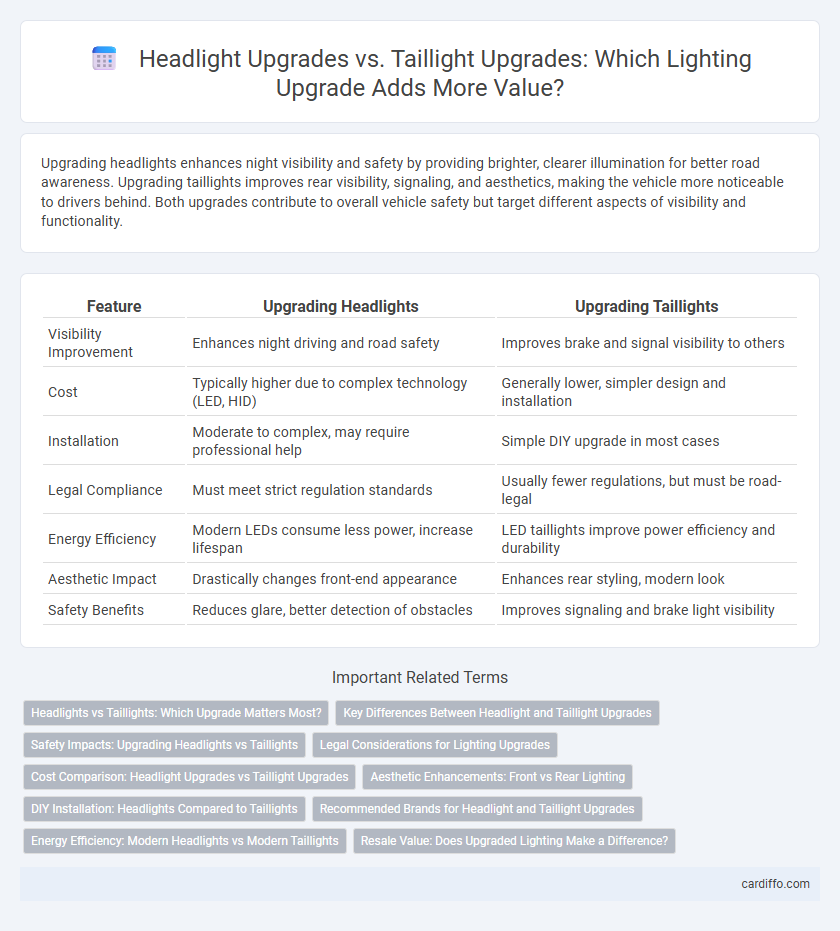Upgrading headlights enhances night visibility and safety by providing brighter, clearer illumination for better road awareness. Upgrading taillights improves rear visibility, signaling, and aesthetics, making the vehicle more noticeable to drivers behind. Both upgrades contribute to overall vehicle safety but target different aspects of visibility and functionality.
Table of Comparison
| Feature | Upgrading Headlights | Upgrading Taillights |
|---|---|---|
| Visibility Improvement | Enhances night driving and road safety | Improves brake and signal visibility to others |
| Cost | Typically higher due to complex technology (LED, HID) | Generally lower, simpler design and installation |
| Installation | Moderate to complex, may require professional help | Simple DIY upgrade in most cases |
| Legal Compliance | Must meet strict regulation standards | Usually fewer regulations, but must be road-legal |
| Energy Efficiency | Modern LEDs consume less power, increase lifespan | LED taillights improve power efficiency and durability |
| Aesthetic Impact | Drastically changes front-end appearance | Enhances rear styling, modern look |
| Safety Benefits | Reduces glare, better detection of obstacles | Improves signaling and brake light visibility |
Headlights vs Taillights: Which Upgrade Matters Most?
Upgrading headlights significantly enhances nighttime visibility and driving safety, providing brighter, more focused beams that improve reaction times and reduce accidents. While taillight upgrades improve rear visibility and signaling clarity, they generally have less impact on overall driving safety compared to headlights. Prioritizing headlight upgrades offers a more critical improvement in road illumination and driver confidence during low-light conditions.
Key Differences Between Headlight and Taillight Upgrades
Upgrading headlights primarily enhances visibility and safety during nighttime driving by offering brighter, more focused beams with technologies like LED or HID. Taillight upgrades focus on improving vehicle signaling and brake light responsiveness, often incorporating LED arrays for faster illumination and increased durability. The key difference lies in their function: headlights ensure forward visibility, while taillights ensure rear visibility and communication to other drivers.
Safety Impacts: Upgrading Headlights vs Taillights
Upgrading headlights significantly enhances nighttime visibility, reducing the risk of accidents by improving the driver's ability to see road hazards and pedestrians. Upgraded taillights, while less critical for forward vision, increase vehicle conspicuity to other drivers, especially during braking and adverse weather conditions. Prioritizing headlight upgrades often yields greater safety benefits by directly impacting driver awareness and reaction times.
Legal Considerations for Lighting Upgrades
Upgrading headlights requires compliance with federal standards set by the National Highway Traffic Safety Administration (NHTSA) to ensure proper brightness and beam pattern, preventing glare or reduced visibility for other drivers. Taillight upgrades must adhere to regulations regarding color, brightness, and functionality, including brake and turn signal visibility, to maintain safety and pass vehicle inspections. Both lighting upgrades should meet the Society of Automotive Engineers (SAE) standards to avoid legal issues and ensure road safety.
Cost Comparison: Headlight Upgrades vs Taillight Upgrades
Upgrading headlights typically costs between $150 and $700 depending on the type of bulbs and technology, such as LED or HID systems. Taillight upgrades are generally less expensive, ranging from $50 to $300, primarily due to simpler LED replacements or lens modifications. The cost difference reflects the complexity and functionality of headlight systems versus taillight assemblies in vehicle upgrades.
Aesthetic Enhancements: Front vs Rear Lighting
Upgrading headlights significantly enhances the vehicle's front-end aesthetics, offering modern LED or projector designs that improve visibility and create a sleek, aggressive look. In contrast, upgrading taillights adds a bold, refined appearance to the rear, often incorporating dynamic turn signals and smoked or crystal lenses for a personalized touch. Both upgrades contribute to a balanced visual appeal, with headlights emphasizing sophistication and functionality while taillights provide distinctive rear styling and improved signaling safety.
DIY Installation: Headlights Compared to Taillights
Upgrading headlights often involves more complex wiring and alignment adjustments compared to taillights, making DIY installation more challenging. Headlights require precise aiming to ensure proper road illumination and avoid blinding other drivers, whereas taillights mainly involve straightforward bulb replacement or LED module swaps. DIY enthusiasts typically find upgrading taillights more accessible due to simpler electrical connections and fewer alignment concerns.
Recommended Brands for Headlight and Taillight Upgrades
When upgrading headlights, popular recommended brands include Philips, Sylvania, and Osram, known for their brightness and longevity. For taillight upgrades, consider options from Spyder Auto, Morimoto, and Anzo, which offer durable, high-quality designs and enhanced visibility. Choosing these trusted brands ensures improved safety and aesthetic appeal for vehicle lighting upgrades.
Energy Efficiency: Modern Headlights vs Modern Taillights
Modern headlights and taillights both utilize LED technology, significantly improving energy efficiency compared to traditional bulbs; however, headlights consume more power due to higher brightness levels needed for road visibility. Upgrading to LED headlights can reduce energy consumption by up to 70%, while LED taillights offer approximately 50% energy savings over incandescent versions. Efficient modern lighting not only enhances vehicle safety but also contributes to lower overall energy usage and prolonged battery life.
Resale Value: Does Upgraded Lighting Make a Difference?
Upgrading headlights can significantly enhance resale value by improving nighttime visibility and modernizing a vehicle's appearance, which appeals to buyers prioritizing safety and style. While upgraded taillights contribute to aesthetics and visibility, their impact on resale value is generally less pronounced compared to headlights. Investing in high-quality LED or HID headlights often yields a better return on investment when selling a vehicle.
Upgrading Headlights vs Upgrading Taillights Infographic

 cardiffo.com
cardiffo.com